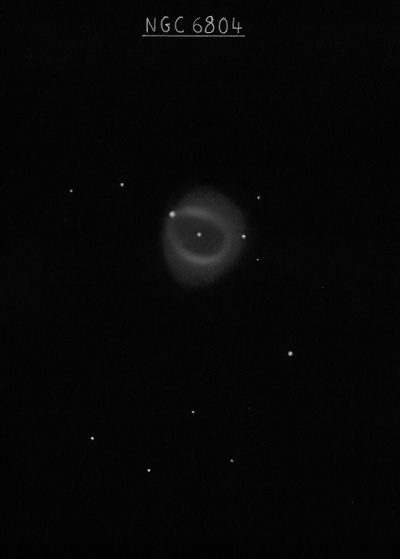
William Herschel discovered NGC 6804 = H VI-38 = h2043 on 25 Aug 1791 (sweep 1018) and recorded "cB, S, iF, easily resolvable. Some of the stars visible." He mistakenly placed this planetary nebula in classification class VI of "Very compressed and rich clusters of stars." John Herschel also assumed it was a cluster, though on his first of four observations (21 Aug 1827), he logged "doubtful if a resolved cl or a neb of first class. pL; R; bM; 60"; with 2 or 3 accidental stars of the Milky Way." Confirmed as a planetary by Francis Pease in 1917.
Based on Crossley photographs at Lick, Curtis (1918) wrote, "an irregular ring 33" from north to south and 30" from E to W; brightest on north and south and fades out along an axis in p.a. 48°. The oval disk of much fainter matter outside is 63"x50" in p.a. 0°, and stronger at western and southern edges."
300/350mm - 13" (8/5/83): moderately bright, elongated WSW-ENE. Unusual appearance as four faint stars are very near or involved including the faint mag 14 central star visible with averted vision. A mag 13 star is at the NE edge 27" from the center, a very faint mag 15 star is at west edge and a similar star is just NW. The rim is possibly slightly brighter on the east edge.
400/500mm - 17.5" (7/11/99): at lower powers appears moderately bright, irregularly round, ~1' diameter with several stars involved or nearby. At 280x, the view is very unusual with three stars involved and others nearby. The brightest is a mag 12.5-13 star at the NE edge. The mag 14 central star is visible with direct vision. Finally, a mag 14.5-15 star is at or just off the west side. The planetary is slightly elongated 4:3 SW-NE with an irregular surface brightness. The rim appears brighter along the east and northeast side and weakest at the west edge. Nearby stars include a mag 13 star ~1.5' NE (nearly on a line with the central star and the star on the northeast edge) and a mag 15-15.5 star close south-southwest of the star at the west edge.
600/800mm - 24" (6/30/16): at 501x (unfiltered): bright, irregular planetary with interesting structure! The overall shape is roughly oval, extending WSW-ENE, ~0.7'x0.5'. The 14th magnitude central star is very easy. A brighter mag 12.5-13 star is along the rim on the northeast side and a fainter mag 14-14.5 star is at the west edge of the rim. The latter star has a mag 15-15.5 companion 12" SSW. Also a 10" pair of mag 14/15 stars is off the northeast side. The rim is brightest along thin 90° strips centered on the southeast and northwest side and weak or open on the southwest side. Along with the brighter star on the northeast end, this creates a "C" or horseshoe appearance with a darker center.
Notes by Steve Gottlieb